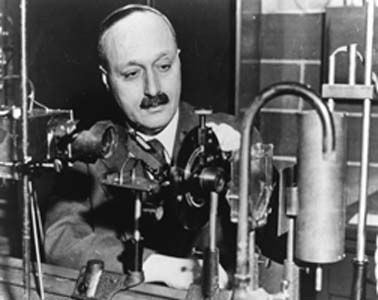- James Franck
Infobox_Scientist
name = James Franck

image_width = 220px
caption = James Franck (1882-1964)
birth_date = birth date|1882|8|26|df=y
birth_place =Hamburg ,German Empire
nationality =Germany
death_date = death date and age|1964|5|21|1882|8|26
death_place =Göttingen ,West Germany
field =Physics
work_institution = University of BerlinUniversity of Göttingen Johns Hopkins University University of Chicago
alma_mater =University of Heidelberg
University of Berlin
doctoral_advisor =Emil Gabriel Warburg
doctoral_students =Wilhelm Hanle Arthur R. von Hippel
known_for =Franck-Condon principle Franck-Hertz experiment
prizes =Nobel Prize for Physics (1925)
religion =Jewish
footnotes =James Franck (
August 26 ,1882 –May 21 ,1964 ) was a German-bornphysicist and Nobel laureate fromHamburg .Education and career
Franck completed his PhD in 1906 and received his "
venia legendi " for physics in 1911, both at the University of Berlin, where he lectured and taught until 1918, having reached the position of extraordinarius professor. AfterWorld War I , in which he served and was awarded theIron Cross 1st Class, Franck became the Head of the Physics Division of the Kaiser Wilhelm Gesellschaft for Physical Chemistry. In 1920, Franck became ordinarius professor of experimental physics and Director of the Second Institute for Experimental Physics at theUniversity of Göttingen . While at the university, he worked onquantum physics withMax Born , who was Director of the Institute of Theoretical Physics.In 1925, Franck received the
Nobel Prize in Physics , mostly for his work in 1912-1914 which included theFranck-Hertz experiment , an important confirmation of theBohr model of theatom .In 1933, after the Nazis came to power, he left his post in Germany and continued his research in the United States, first at the
Johns Hopkins University in Baltimore and then, after a year inDenmark , in Chicago. This is where he became involved in theManhattan Project duringWorld War II ; he was Director of the Chemistry Division of theMetallurgical Laboratory [ The Metallurgical Laboratory – known as the Met Lab – was one of four main sites working on the Manhattan Project. The other three wereLos Alamos Scientific Laboratory ,Oak Ridge National Laboratory , andHanford Site .] at theUniversity of Chicago . He was also the chairman of the Committee on Political and Social Problems regarding the atomic bomb; the committee consisted of himself and other scientists at the Met Lab, includingDonald J. Hughes ,J. J. Nickson ,Eugene Rabinowitch ,Glenn T. Seaborg ,J. C. Stearns andLeo Szilard . The committee is most known for the compilation of theFranck Report , finished onJune 11 ,1945 , which was a summary of the problems regarding the military application of the Atomic Bomb.When
Nazi Germany invaded Denmark inWorld War II , the Hungarian chemistGeorge de Hevesy dissolved the goldNobel Prize s ofMax von Laue and James Franck inaqua regia to prevent the Nazis from stealing them. He placed the resulting solution on a shelf in his laboratory at theNiels Bohr Institute . After the war, he returned to find the solution undisturbed and precipitated the gold out of the acid. The Nobel Society then recast the Nobel Prizes using the original gold.In 1946 Franck married
Hertha Sponer , his former assistant in Göttingen. He died suddenly in 1964 while visiting Göttingen. [http://www.phy.duke.edu/about/HerthaSponer/]Honours and awards
* 1925
Nobel Prize in Physics The award was shared withGustav Ludwig Hertz , and it was for their discovery of the laws governing the impact of electrons on atoms.
* 1951 Max Planck Medaille der Deutschen Physikalischen Gesellschaft
* 1953 Honorary citizen of Göttingen
* 1955Rumford Medal of the American Academy of Arts and Sciences - For his work on photosynthesis.
* 1964 Elected as a Foreign Member of theRoyal Society of London , for his contribution to the understanding of exchanges of energy in electron collisions, to the interpretation of molecular spectra, and to problems of photosynthesis.ee also
*
Franck-Condon principle
*Franck-Hertz experiment References
*cite journal | last=Kuhn | first=H.G. | coauthors= | title=James Franck, 1882-1964 | journal=Biographical Memoirs of Fellows of the Royal Society | volume=11 | issue= | pages=53–74 | year=1965 | url=http://links.jstor.org/sici?sici=0080-4606%28196511%2911%3C53%3AJF1%3E2.0.CO%3B2-V | accessdate=2008-03-03| doi=10.1098/rsbm.1965.0004
*cite journal
quotes = no
last=Shampo
first=M A
authorlink=
coauthors=Kyle R A
year=1984
month=Sep
title=James Franck and Gustav Hertz
journal=JAMA
volume=252
issue=11
pages=1426
publisher = | location =
pmid = 6381774
bibcode = | oclc =| id = | url = | language = | format = | accessdate = | laysummary = | laysource = | laydate = | quote =
doi=10.1001/jama.252.11.1426
*cite journal
quotes = no
last=Rosenberg
first=Jerome L
authorlink=
year=2004
month=
title=The contributions of james franck to photosynthesis research: a tribute
journal=Photosyn. Res.
volume=80
issue=1-3
pages=71–6
publisher = | location =
pmid = 16328811
doi = 10.1023/B:PRES.0000030453.66865.f6
bibcode = | oclc =| id = | url = | language = | format = | accessdate = | laysummary = | laysource = | laydate = | quote =External links
*http://nobelprize.org/physics/laureates/1925/franck-bio.html biography, on the Nobel website
* [http://alsos.wlu.edu/qsearch.aspx?browse=people/Franck,+James Annotated bibliography for James Franck from the Alsos Digital Library for Nuclear Issues]
* [http://www.amphilsoc.org/library/guides/ahqp/bios.htm James Franck Biography] – American Philosophical Society (Bio appears after Sommerfeld's)Persondata
NAME= Franck, James
ALTERNATIVE NAMES=
SHORT DESCRIPTION=GermanPhysicist
DATE OF BIRTH=August 26 ,1882
PLACE OF BIRTH=Hamburg ,Germany
DATE OF DEATH=May 21 ,1964
PLACE OF DEATH=Göttingen ,Germany
Wikimedia Foundation. 2010.
